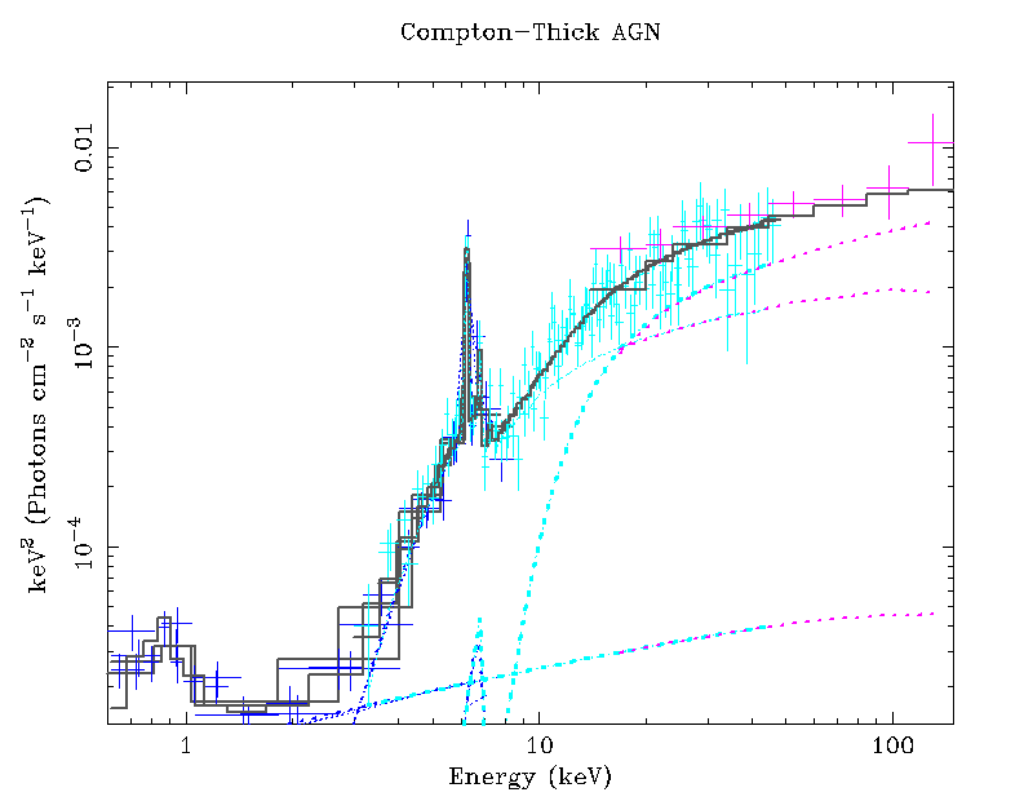The goal of the Clemson-INAF Compton thick AGN project is to have a complete census of the heavily obscured active galactic nuclei (AGN) in the local Universe observed between 15 and 150 keV. That is, a detailed characterization of the properties of obscured AGN within redshift z < 0.05 (d < 200 Mpc).
The motivation behind this project is the discrepancy between the fraction of Compton-thick AGN (with large obscuring hydrogen column densities, NH > 1.5 x 1024 cm-2) observed in surveys and the fraction predicted by AGN population synthesis models. A much larger fraction than is currently observed is necessary to explain the Cosmic X-ray Background (CXB).
Obscured AGN are elusive, since the large amounts of gas and dust surrounding them can dim their emission to non-detectable levels, particularly at optical/UV wavelengths. While unobscured AGN are easily detected, those obscured remain hidden; effectively biasing our results. X-ray emission can shine through large column gas densities, which completely obscure longer wavelengths. In fact, not only can X-rays see these slippery sources; they are also the ideal tool to characterize their properties.
This project uses X-ray observations to characterize local AGN, within a redshift small enough for even dim, obscured AGN to be detectable. Thus, our final objective is to obtain the true fraction of Compton-thick AGN in the local Universe.
Swift-BAT
The Burst Alert Telescope (BAT) on board the Swift observatory is an instrument designed to provide critical gamma-ray burst triggers as it surveys the whole sky. The BAT is sensitive in the 15-150 keV range (hard X-rays). While searching for bursts, the BAT performs an all-sky hard X-ray survey and monitors for hard X-ray transients. The Swift-BAT 105 month catalog reports the results of this survey, including 1632 hard X-ray sources, a ~60% of which are non-beamed AGN in nearby (z < 0.2) galaxies.
Highly obscured AGN, however, cannot be easily observed at such large redshifts as they are inherently fainter. In order to have a complete sample, it must be limited to a smaller volume. Since BAT is effective in detecting highly obscured AGN only in the very nearby Universe, we are developing a volume-limited sample of AGN detected by BAT in 150 months of observations within z < 0.05 (200 Mpc). This will allow us to determine the true Compton-thick fraction in the near Universe. The BAT 150 month catalog can be found here.
The high-energy X-rays detected by BAT are not as easily absorbed as those at lower wavelengths, making it an ideal tool to find obscured sources. However, with BAT data alone it is not possible to determine their Compton-thick (or, otherwise, Compton-thin) nature. It is necessary to follow-up these detections with observations at lower energies, which can probe the level of obscuration in the source (see below).
Compton Thick AGN in X-rays

X-ray data is an ideal tool to study obscured AGN. Our group makes use of all facilities available to us in order to have the broadest possible X-ray coverage of their emission: Chandra and XMM-Newton in the ~0.5-10 keV range, NuSTAR in the 3-79 keV range, and Swift-BAT in the 15-150 keV range.
This image shows the spectrum of a Compton-Thick source, from 0.5 to 150 keV, combining data of XMM-Newton, NuSTAR and Swift-BAT. The X-ray emission of the source is absorbed below ~10 keV. As harder X-rays penetrate the surrounding material more easily, there is a rise in flux toward higher photon energies. The exact shape of this rising curve is in fact related to the absorbing column density, NH.
Through modeling the X-ray spectra of AGN we can constrain properties such as the hydrogen column density in our line of sight, the average hydrogen column density of the dense material surrounding the source in all directions (torus), the covering factor of this material and the angle at which we observe the source with respect to it. More details on the physics and modeling of these sources can be found in Project.
The CCTAGN Website
Project
Details on the project and on the astrophysics questions driving it can be found in Project. In this section we describe the structure of an accreting supermassive blackhole, the origin of its multiwavelength emission, the exact characteristics of its X-ray emission, and he peculiarities of Compton-thick AGN.
Data
All sources analyzed as part of the project are listed in Data. In this section of our website you can find a fully searchable table with the parameters derived from the spectral analysis. You can also download all data products (spectra and best-fit models), or visualize them online.
People
The X-ray astronomy group in the Physics and Astronomy department at Clemson University is actively studying AGN, and works in close collaboration with the extragalactic astronomy group at the INAF-OAS Bologna and INAF-IASF Palermo.
Meet our researchers in People.

